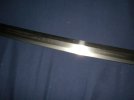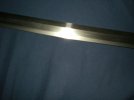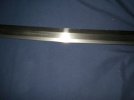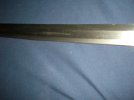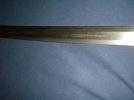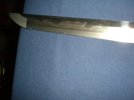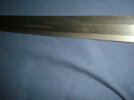I posted this sword on another sword forum awhile ago and got some good information. I would appreciate some info on the mounts and is there a year in the signature. The translation I got there was Gunsui sword made by Kanekuni with no year. The other side of the tang is unmarked. I was told it was from pre WW2 and probably remounted. Then I read that high ranking Japanese officers got the gunsui swords and were allowed these types of mounts during the war. Also, what kind of handle wrap is this. It's a hard black substance. The hamon is pretty much straight. Thank you
Kanekuni is a sword smith of Mino province.
It could be observed as an early Muromachi period (1336-1392) if the signature was engraved correctly.
At first glance, it seems to be a Yamato school sword but from the filing pattern on the nakago, we could determine that it is a Mino sword.
It is katate-uchi shape in saya and seems to be a nice and thick blade which alone would command about $9-12k or more with Nokubetsu Hozan papers, but the signature is not on par.
The Saya is definitely early 1900’s WWI (sword sheath), about 1870, the feudal system is abolished and most swords that carried on, will have a notably shortened tang (usually at the 2nd meguki) they were often hidden in this way as walking sticks in full wooden enclosures or Shirasaya. Wood Saya and Handle (Tsuka) disguised as 1.
Since we don’t have a full tang photo, we could say 1 or the other, it is possible the sword was hidden during the Westernization of Japan and was made by a student of Kanekuni, if intact.
It looks as if the sageo (handle wrap) is lacquered black leather, as silk would have been used in the time of Kanekuni, we can certainly say this is not original. I cannot say who made your mounting decorations, but they are not pre WWI…
The base of this Saya where sheath meets Tsuba is wrapped in bronze with the Kanji “Mortal Instrument” inlaid in brass or gold… This to me says, all your fittings are from the mount or remount of this blade, seeing as none are more or less substantial in patina.
My opinion of your fittings is that these (Koshirae) were made at the turn of the century 1914-18… When the blade was mounted/remounted. Basically Edo period koshirae command from $600-1200. Blades from $1-2000.
Total sword as is appraisal (no Nihinto papers) is approximately $2-3,000… Without low light flash photography showing the blades actual attributes or NBHK papers I’m afraid this could be a forgery and nothing else can be said.
Since metals generally cannot be carbon dated without inclusions of once living organisms, metal dating is nearly impossible and visually ascertained… If the Saya (Scabbard) and Tsuka (wooden Hilt covering) were original, they could be dated and lead to positive identification.
As it is Kanekuni’s signature is very much un-like yours, so at the very best the maker was a student, at the very least, this in Edo period katana, which I am more likely to recommend, as the Kanji are large and boxy not small fluid strokes as would be seen 500 years prior.
FYI, 1136-1300, only one ana (hole in hilt for mekago (decorative menuki) is seen. At the time it was not perceived that leveraging a swords follow through had anything to do with hilt length… In about 1320, we see the traditional katana take shape… Where blades were made in accordance to a Warrior’s Step (Inseam was equivalent to blade length) and Tsuka to Reach (a warrior’s forearm length became the handle)… Therefore 2 ana (holes in hilt). Cutting length apx. 28” hilt 7.5-8, Tsuka 9.5-10”.
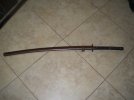 CIMG0002 (18).JPG431.8 KB · Views: 20
CIMG0002 (18).JPG431.8 KB · Views: 20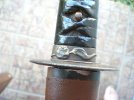 CIMG0003 (14).JPG420.7 KB · Views: 20
CIMG0003 (14).JPG420.7 KB · Views: 20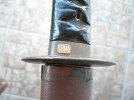 CIMG0005 (13).JPG445.8 KB · Views: 18
CIMG0005 (13).JPG445.8 KB · Views: 18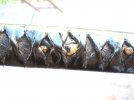 CIMG0006 (9).JPG347.6 KB · Views: 18
CIMG0006 (9).JPG347.6 KB · Views: 18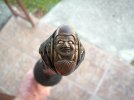 CIMG0007 (4).JPG369.7 KB · Views: 18
CIMG0007 (4).JPG369.7 KB · Views: 18 CIMG0008 (4).JPG444.9 KB · Views: 18
CIMG0008 (4).JPG444.9 KB · Views: 18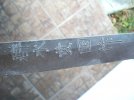 CIMG0012 (1).JPG430.8 KB · Views: 20
CIMG0012 (1).JPG430.8 KB · Views: 20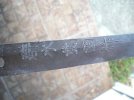 CIMG0013 (1).JPG456.4 KB · Views: 19
CIMG0013 (1).JPG456.4 KB · Views: 19



